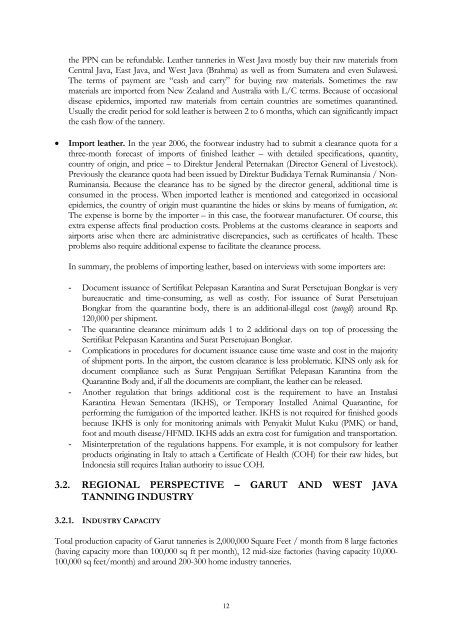ACCESS OF FOOTWEAR RAW MATERIAL INPUTS - part - USAid
ACCESS OF FOOTWEAR RAW MATERIAL INPUTS - part - USAid
ACCESS OF FOOTWEAR RAW MATERIAL INPUTS - part - USAid
You also want an ePaper? Increase the reach of your titles
YUMPU automatically turns print PDFs into web optimized ePapers that Google loves.
the PPN can be refundable. Leather tanneries in West Java mostly buy their raw materials from<br />
Central Java, East Java, and West Java (Brahma) as well as from Sumatera and even Sulawesi.<br />
The terms of payment are “cash and carry” for buying raw materials. Sometimes the raw<br />
materials are imported from New Zealand and Australia with L/C terms. Because of occasional<br />
disease epidemics, imported raw materials from certain countries are sometimes quarantined.<br />
Usually the credit period for sold leather is between 2 to 6 months, which can significantly impact<br />
the cash flow of the tannery.<br />
• Import leather. In the year 2006, the footwear industry had to submit a clearance quota for a<br />
three-month forecast of imports of finished leather – with detailed specifications, quantity,<br />
country of origin, and price – to Direktur Jenderal Peternakan (Director General of Livestock).<br />
Previously the clearance quota had been issued by Direktur Budidaya Ternak Ruminansia / Non-<br />
Ruminansia. Because the clearance has to be signed by the director general, additional time is<br />
consumed in the process. When imported leather is mentioned and categorized in occasional<br />
epidemics, the country of origin must quarantine the hides or skins by means of fumigation, etc.<br />
The expense is borne by the importer – in this case, the footwear manufacturer. Of course, this<br />
extra expense affects final production costs. Problems at the customs clearance in seaports and<br />
airports arise when there are administrative discrepancies, such as certificates of health. These<br />
problems also require additional expense to facilitate the clearance process.<br />
In summary, the problems of importing leather, based on interviews with some importers are:<br />
- Document issuance of Sertifikat Pelepasan Karantina and Surat Persetujuan Bongkar is very<br />
bureaucratic and time-consuming, as well as costly. For issuance of Surat Persetujuan<br />
Bongkar from the quarantine body, there is an additional-illegal cost (pungli) around Rp.<br />
120,000 per shipment.<br />
- The quarantine clearance minimum adds 1 to 2 additional days on top of processing the<br />
Sertifikat Pelepasan Karantina and Surat Persetujuan Bongkar.<br />
- Complications in procedures for document issuance cause time waste and cost in the majority<br />
of shipment ports. In the airport, the custom clearance is less problematic. KINS only ask for<br />
document compliance such as Surat Pengajuan Sertifikat Pelepasan Karantina from the<br />
Quarantine Body and, if all the documents are compliant, the leather can be released.<br />
- Another regulation that brings additional cost is the requirement to have an Instalasi<br />
Karantina Hewan Sementara (IKHS), or Temporary Installed Animal Quarantine, for<br />
performing the fumigation of the imported leather. IKHS is not required for finished goods<br />
because IKHS is only for monitoring animals with Penyakit Mulut Kuku (PMK) or hand,<br />
foot and mouth disease/HFMD. IKHS adds an extra cost for fumigation and transportation.<br />
- Misinterpretation of the regulations happens. For example, it is not compulsory for leather<br />
products originating in Italy to attach a Certificate of Health (COH) for their raw hides, but<br />
Indonesia still requires Italian authority to issue COH.<br />
3.2. REGIONAL PERSPECTIVE – GARUT AND WEST JAVA<br />
TANNING INDUSTRY<br />
3.2.1. INDUSTRY CAPACITY<br />
Total production capacity of Garut tanneries is 2,000,000 Square Feet / month from 8 large factories<br />
(having capacity more than 100,000 sq ft per month), 12 mid-size factories (having capacity 10,000-<br />
100,000 sq feet/month) and around 200-300 home industry tanneries.<br />
12

















